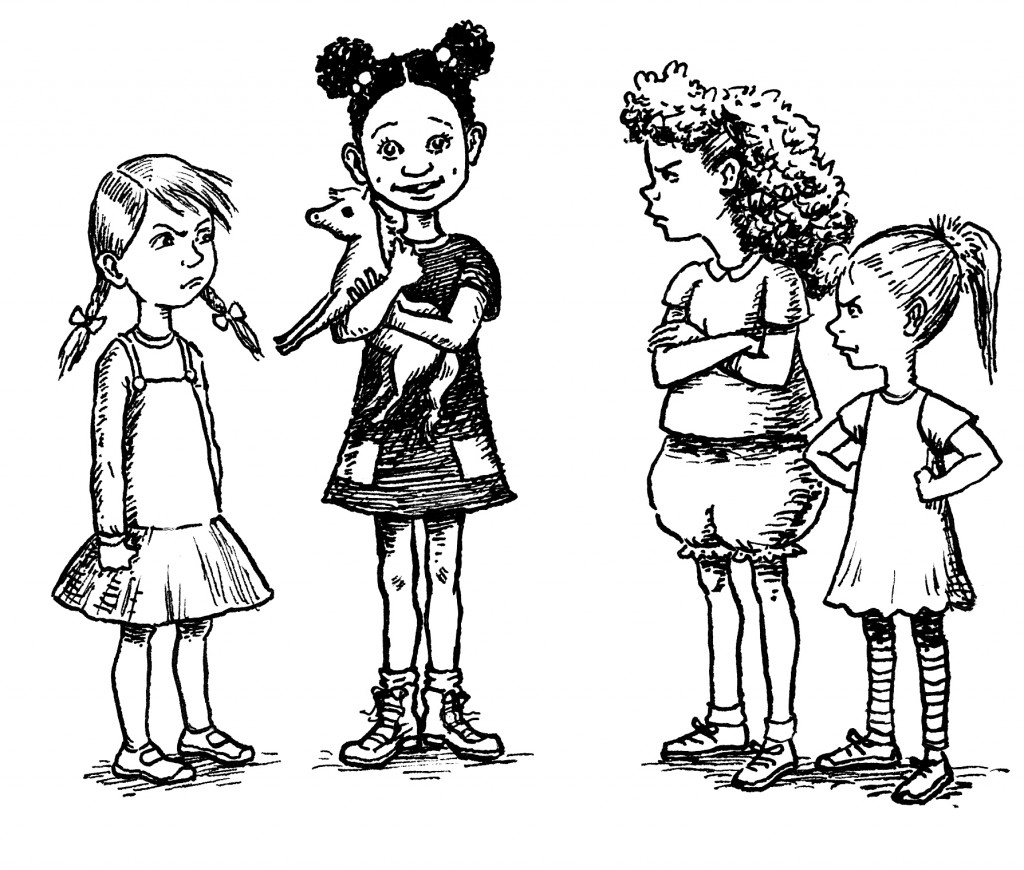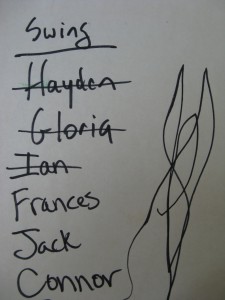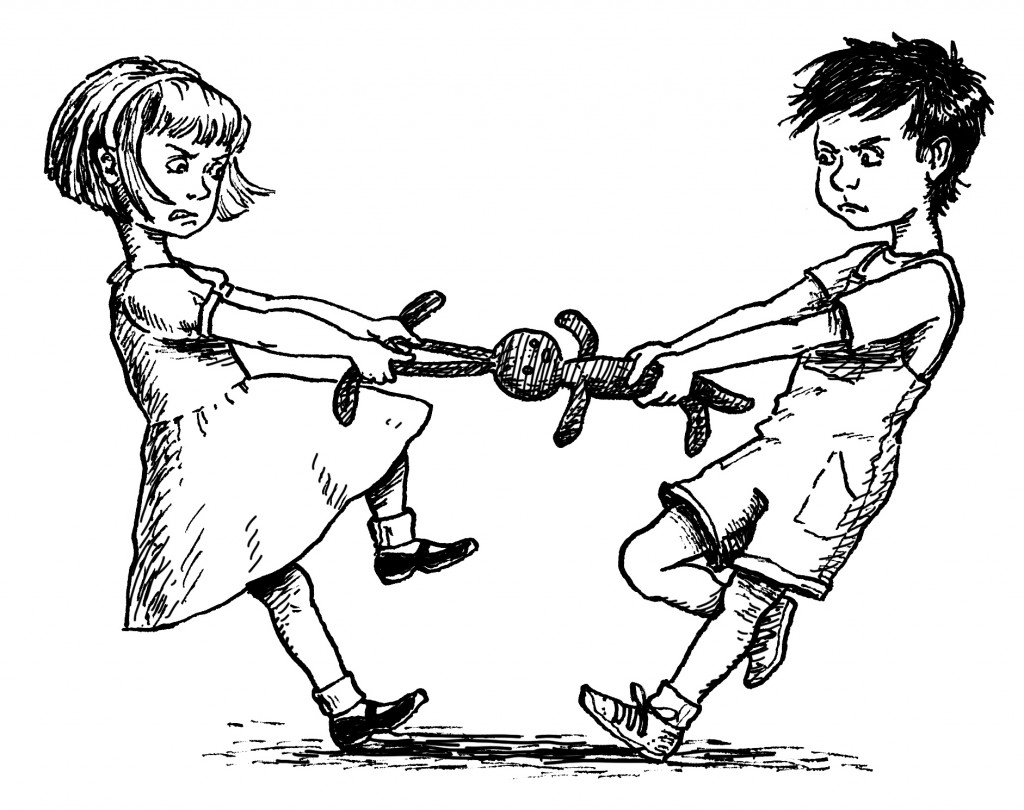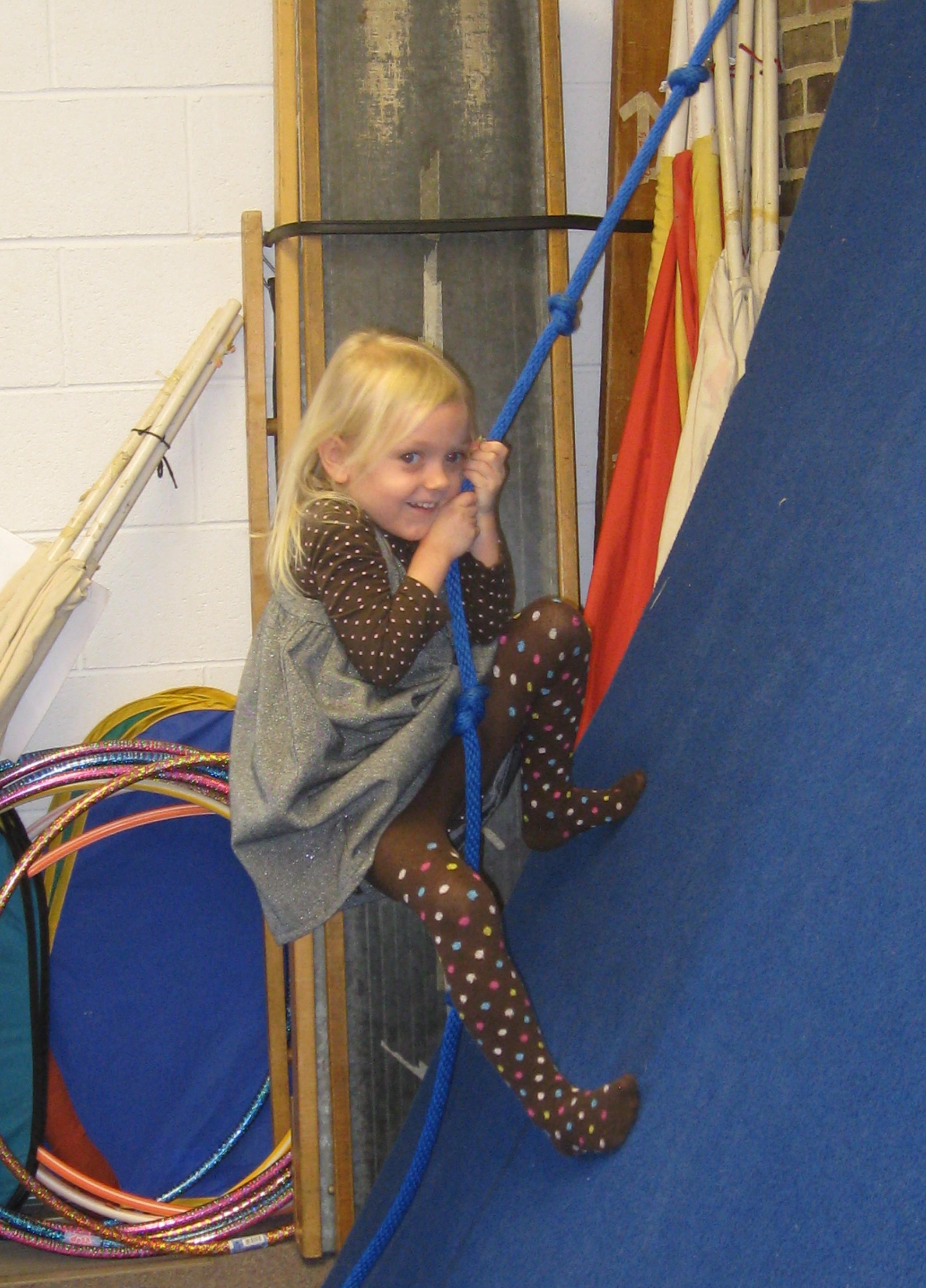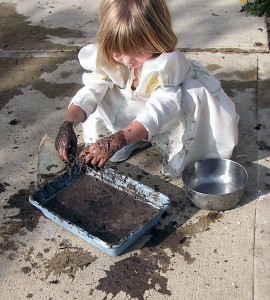A World of Books and Children
Search and enjoy 8 years of posts chock-filled with ideas from It’s OK Not to Share and beyond.
Turn-taking based on when the child decides she’s “All Done” is fair and simple (see previous post Sharing: Throw Away Your Timer). But what happens when a child hogs the ball or decides to take a really looonnnnngggg turn?
When you put your child in charge of deciding when she’s all done, her turn might be five seconds, or it might be five hours. Time doesn't mean much to a young child. Finishing what she's involved in is what counts.
Long turns are not selfish, anti-social or unkind. This idea may take some getting used to, if you're an adult. Long turns are OK. In fact, long turns should be respected just as much as short ones.
A child takes a long turn to get a need met. It may be a need for motion (a swing), a need for trust, a need for control, or simply a need to explore an intense interest.
Kids typically take long turns if they're new at child-directed turn-taking. Why? They hog a toy to test the system. It's a matter of building trust. "Will dad really let me have the pony until I'm all done?" When they feel safe, they relax. Kids who have been forced to share in the past may take very long turns, but after they trust the system they begin to relax. The turns get shorter.
Some kids have a need for control. Hanging on to one object and controlling can be a way to feel safe. Address the underlying fear. Or give the child other opportunities to experience power and control in their lives (carrying a heavy object, being in charge of something).
Sometimes kids take long turns to practice a new skill or follow an intense interest. It develops focus and attention span. All the repetition may be boring to us (swinging and swinging, or pouring and pouring sand), but it’s exciting to them and these kids are working at an optimal level of learning.
How long is too long? What about waiting for the long turn to be done?
There is no real limit to how long a turn can be. Trust that at some point, the child will be "All Done." Some schools make signs that save the object for the next day. "Work in Progress." or "Saving for Sammy." If lunch interrupts the play, the turn can continue after lunch.
In a group situation, such as a preschool, home daycare or large family, use the magic tool of the Waiting List. This works well for popular, but limited, items such as swings. Simply write the names of waiting kids. Kids learn sequence and pre-literacy skills as they look for their names on the list. Soon you'll have children "writing" their names on their own waiting lists. It may look like scribbles, but they'll know exactly whose turn is next.
Counterintuitively, long turns offer another way for children to gain social skills and awareness of others. If a child's been waiting a long time, it's OK for him to be mad or frustrated and tell the other child how he feels. This helps kids who take long turns learn that their actions impact others. Meanwhile, the waiting child is learning delayed gratification and how to cope with negative emotions - vital life skills.
Finally, rules may be different for crowded, public areas. Some items are for everyone. Long turns don't work everywhere. If you're at a crowded children's museum, tell your kids the rules are different there. Then make room for long turns when you can.
Words you can say
Protecting long turns
- It’s OK to have a long turn.
- Yes, she’s having a long turn. When it’s your turn, you can have a long turn, too.
- Zoe doesn’t have to give it to you, but you can tell her how you feel.
- Tell her you’re tired of waiting! You can say you’ve been waiting all morning and it makes you mad.
- Let’s make a waiting list.
- Look – you’re next after Danny. Your name is right here at the top.
Sharing crowded or public space
- The climber is for everyone.
- There are lots of other kids here. Today we need to take fast turns.
- At home you can take a long turn. At the museum it’s different.
- Your turn’s done. If you want to do more, you need to line up and wait for another turn.
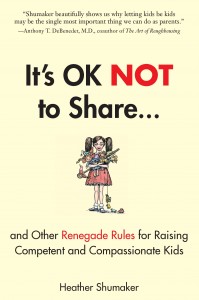 Learn more about handling long turns in It’s OK Not to Share…And Other Renegade Rules for Raising Competent and Compassionate Kids. Sharing and long turns are just two of the 29 “renegade rules.” Or watch this short video.
Learn more about handling long turns in It’s OK Not to Share…And Other Renegade Rules for Raising Competent and Compassionate Kids. Sharing and long turns are just two of the 29 “renegade rules.” Or watch this short video.
As soon as children are old enough to walk, we expect them to share. I prefer putting "share" in quotes, since this type of sharing is usually forced by the adult. Our goals are noble: kindness, generosity, awareness of others. Unfortunately, our approach backfires.
Kids learn more life skills --and develop better generosity--when they aren't forced to share.
Of course, sharing squabbles happen all the time between kids. Here’s a typical scene: One child is busily engaged with a toy when a new child comes up and wants it. A nearby adult says: “Be nice and share your toys,” or “Give Ella the pony. You’ve had it a long time.” What happens? The child is forced to give something up and her play gets interrupted. She learns that sharing feels bad. It’s the parent who’s sharing here, not the child.
Traditional sharing expects kids to give up something the instant someone else demands. Yet we don’t do this ourselves. Imagine being on your cell phone when somebody suddenly comes up and asks for your phone or takes it from you. “I need to make a phone call,” he says. Would you get mad? As adults, we expect people to wait their turn. We might gladly lend our phone to a friend or even a stranger, but we want them to wait until we’re done. The same should apply to kids: let the child keep a toy until she’s “all done.” It’s turn-taking. It’s sharing. But the key is it’s child-directed turn-taking.
Positive assertiveness
Here’s what it looks like in real life. Instead of YOU saying “Five more minutes, then it’s Ella’s turn” or "I'm going to set the timer," teach your child to say “You can have it when I’m done.” This teaches positive assertiveness. It helps kids stand up for themselves and learn to set boundaries on other kids. What a terrific life skill. How many of us as adults have trouble saying “no?”
True Generosity and Awareness of Others
When the first child drops the toy and moves on, remind her that Ella’s waiting for a turn (a great lesson in courtesy and awareness of others). The best part of all is when the first child willingly hands over the toy—it’s a joyous moment for both kids. That’s the moment when your child experiences the rush of good feelings that comes from being kind to others. It’s true generosity. It’s a warm feeling. One she’ll want to repeat over and over – whether a parent is watching or not.
Emotional Impulse Control
What about the waiting child? Waiting is hard, especially for impulsive 2-6 year olds, but just like assertiveness, waiting is an excellent life skill. It’s OK for the waiting child to feel frustrated, sad or angry for a time. Don’t be afraid of a few foot stompings or tears. Learning to control behavior and express intense feelings appropriately is really the main job of early childhood. Impulse control (waiting for a toy and not grabbing) is a vital part of brain development and gets stronger through practice. The more practice kids get, the better. Sharing through turn-taking provides excellent practice.
Life is much more relaxing when you stop playing referee. Throw away your timer. Kids pick up the new method quickly, because it's fair and simple. Let kids keep a toy until they are "all done."
Words you can say
Positive assertiveness
- You can play with it until you’re all done.
- Are you finished with your turn? Max says he’s not done yet.
- Did you like it when he grabbed your truck? Tell him to stop!
- Say: “I’m not done. You can have it when I’m done.”
- She can have a turn. When she’s all done, you can have a turn.
- I see Bella still has the pony. She’s still using it.
- You’ll have to wait. I can’t let you take it out of her hands.
Waiting and awareness of others
- Oh, it’s so hard to wait!
- You’re so mad. You really want to play with the pony right now!
- You can be mad, but I can’t let you take the toy.
- Will you tell Max when you’re all done?
- I see you’re not using the truck any more. Go find Ben. Remember, he’s waiting for a turn.
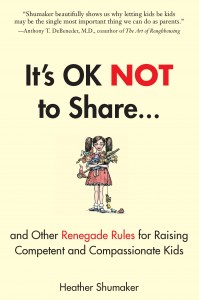 Curious to learn more? See this sharing video and watch for future posts on taking loooong turns, hogging toys, waiting lists and making the transition to turn-taking.
Curious to learn more? See this sharing video and watch for future posts on taking loooong turns, hogging toys, waiting lists and making the transition to turn-taking.
Or check out a free sample chapter from the book It’s OK Not to Share…And Other Renegade Rules for Raising Competent and Compassionate Kids. Sharing and long turns are just two of the 29 “renegade rules.”
Did you ever resent sharing something as a child? Have you tried child-directed sharing?
When I wrote about Centers in child care programs last week, a reader asked me a fundamental question: How do you find a play-based program? How do you know if a preschool or daycare is truly play-based? Her question deserves a thorough answer.
Why? It's not that simple. Many programs speak the "play" language. When I called looking for a good preschool program for my children, I heard a lot of talk about play. Talk but not action. "Oh, sure, we're a play-based program. Here's the schedule: music, Spanish, math, science, gym..."
How to sort through the talk and evaluate a real gem of a program?
Observe. You MUST visit the school and observe the classroom. Often you'll find that although the school has good intentions about play, in reality, play is given short shrift. I've often seen "play time" used as a 2o-minute "in between time" as the teacher sets up the next teacher-led structured activity. You will never know unless you visit in person, preferably for 2-3 hours.
Check the schedule. If there's too much "enrichment" time, beware. I've witnessed supposedly play-based programs with cluttered schedules like this: circle time, music, Spanish, math, lunch, lunch, science, gym... There's simply no time left for unstructured play. Children need blocks of time for unstructured play (at least 1-2 hours at a time). Plus, many kids have a hard time with transitions; when the day is broken up with scheduled activities kids are always in transition.
Are dress-ups welcome? Do you see firefighter hats, tiger suits, princess dresses and capes? A huge part of play includes dressing up and playing "let's pretend" games. It's social, it's imaginative, and it involves deep learning. Schools like Montessori rarely have dress-up clothes at all.
Is there big muscle space? Kids need the option to truly play. This means having space for loud, fast and big play available: chasing, jumping, climbing, biking, swinging, banging. Ideally, kids need the option to access the outside or a big muscle room at any time during play time. Play should not be confined to quiet rooms and tables and chairs.
Don't worry about pretty When you evaluate a classroom, don't dwell on how cute and pretty the classroom is. True play is often messy. The space should look as if active kids use it. Of course, a beautiful classroom can be a welcoming place for play, but it's no guarantee. It's what goes on between the people that counts.
Watch the teachers. Do teachers constantly give directions and show models? ("Everyone get 2 black pompoms for the eyes...") Are they busy directing and controlling the children all the time? Do teachers insist on long circle times instead of letting children pursue their own interests and friendships? Are they respectful of children's play ideas or dismissive? ("That's not nice. What about letting the T. Rex be friends with the other dinosaurs?") Do they direct play? ("You three play in the block corner." "How many blocks are green?") or do they support play? ("I see you're building a ship. What do you need for your game?").
Forget the ABCs. A true play-based program focuses on pre-literacy, not literacy. Songs, finger plays, puppet shows and stories are all appropriate. Fixation on the alphabet is not. Good play-based programs integrate literacy into play by making signs "Lucy's Ice Cream Store" and writing down dictated messages and stories that come from the kids' hearts. "Once there was a pirate named Jack who wanted to be a mermaid..."
Seek out a place with conflict. One of the main values of play is for kids to learn to negotiate and problem-solve with peers. ("You have the red truck! "I need the red truck now!") That's the skill of conflict mediation. Play-based programs recognize the HUGE value of teaching kids conflict mediation skills, and don't solve all kids' problems for them. So ask. "Do you teach kids conflict mediation? Tell me about that."
Think like a kid. If you were 4-years-old, would you want to go there? Is this a place that truly welcomes children's play, children's fears and children's ideas? Teachers should be there to guide and give skills - the rest is up to the kids.
Take heart. Programs that truly "get" play are out there, including the School for Young Children in Columbus, Ohio, where I went to school. They even let kids box and wrestle as part of healthy roughhousing play. Read more about it in It's OK NOT to Share...And Other Renegade Rules for Raising Competent and Compassionate Kids.
What else belongs on this list? How did you know you'd found the "right" school? Do you know a school that's a true gem?

